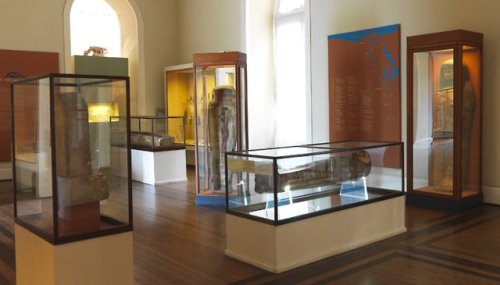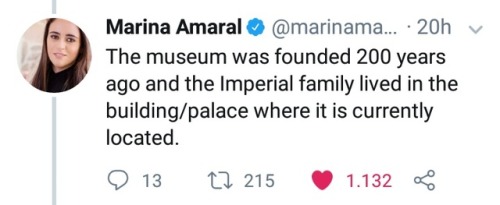Orion E A Explosão De Uma Estrela.
Orion e a explosão de uma estrela.

ALMA views a stellar explosion in Orion
Stellar explosions are most often associated with supernovae, the spectacular deaths of stars. But new ALMA observations of the Orion Nebula complex provide insights into explosions at the other end of the stellar life cycle, star birth. Astronomers captured these dramatic images of the remains of a 500-year-old explosion as they explored the firework-like debris from the birth of a group of massive stars, demonstrating that star formation can be a violent and explosive process too.
The colours in the ALMA data represent the relative Doppler shifting of the millimetre-wavelength light emitted by carbon monoxide gas. The blue colour in the ALMA data represents gas approaching at the highest speeds; the red colour is from gas moving toward us more slowly.
The background image includes optical and near-infrared imaging from both the Gemini South and ESO Very Large Telescope. The famous Trapezium Cluster of hot young stars appears towards the bottom of this image. The ALMA data do not cover the full image shown here.
Credit: ALMA (ESO/NAOJ/NRAO), J. Bally/H. Drass et al.
More Posts from Ritasakano and Others
https://www.instagram.com/p/CQa_cFIgkHb/?utm_medium=copy_link
手作りよだれかけ
Sutil Harmônia

(Image caption: Motor neurons (green) form synapses (highlighted in magenta) on muscle fibers in a fruit fly. MIT neuroscientists have discovered a pathway that contributes to strengthening these synapses. Credit: Troy Littleton)
Neuroscientists reveal how the brain can enhance connections
When the brain forms memories or learns a new task, it encodes the new information by tuning connections between neurons. MIT neuroscientists have discovered a novel mechanism that contributes to the strengthening of these connections, also called synapses.
At each synapse, a presynaptic neuron sends chemical signals to one or more postsynaptic receiving cells. In most previous studies of how these connections evolve, scientists have focused on the role of the postsynaptic neurons. However, the MIT team has found that presynaptic neurons also influence connection strength.
“This mechanism that we’ve uncovered on the presynaptic side adds to a toolkit that we have for understanding how synapses can change,” says Troy Littleton, a professor in the departments of Biology and Brain and Cognitive Sciences at MIT, a member of MIT’s Picower Institute for Learning and Memory, and the senior author of the study, which appears in the Nov. 18 issue of Neuron.
Learning more about how synapses change their connections could help scientists better understand neurodevelopmental disorders such as autism, since many of the genetic alterations linked to autism are found in genes that code for synaptic proteins.
Richard Cho, a research scientist at the Picower Institute, is the paper’s lead author.
Rewiring the brain
One of the biggest questions in the field of neuroscience is how the brain rewires itself in response to changing behavioral conditions — an ability known as plasticity. This is particularly important during early development but continues throughout life as the brain learns and forms new memories.
Over the past 30 years, scientists have found that strong input to a postsynaptic cell causes it to traffic more receptors for neurotransmitters to its surface, amplifying the signal it receives from the presynaptic cell. This phenomenon, known as long-term potentiation (LTP), occurs following persistent, high-frequency stimulation of the synapse. Long-term depression (LTD), a weakening of the postsynaptic response caused by very low-frequency stimulation, can occur when these receptors are removed.
Scientists have focused less on the presynaptic neuron’s role in plasticity, in part because it is more difficult to study, Littleton says.
His lab has spent several years working out the mechanism for how presynaptic cells release neurotransmitter in response to spikes of electrical activity known as action potentials. When the presynaptic neuron registers an influx of calcium ions, carrying the electrical surge of the action potential, vesicles that store neurotransmitters fuse to the cell’s membrane and spill their contents outside the cell, where they bind to receptors on the postsynaptic neuron.
The presynaptic neuron also releases neurotransmitter in the absence of action potentials, in a process called spontaneous release. These “minis” have previously been thought to represent noise occurring in the brain. However, Littleton and Cho found that minis could be regulated to drive synaptic structural plasticity.
To investigate how synapses are strengthened, Littleton and Cho studied a type of synapse known as neuromuscular junctions, in fruit flies. The researchers stimulated the presynaptic neurons with a rapid series of action potentials over a short period of time. As expected, these cells released neurotransmitter synchronously with action potentials. However, to their surprise, the researchers found that mini events were greatly enhanced well after the electrical stimulation had ended.
“Every synapse in the brain is releasing these mini events, but people have largely ignored them because they only induce a very small amount of activity in the postsynaptic cell,” Littleton says. “When we gave a strong activity pulse to these neurons, these mini events, which are normally very low-frequency, suddenly ramped up and they stayed elevated for several minutes before going down.”
Synaptic growth
The enhancement of minis appears to provoke the postsynaptic neuron to release a signaling factor, still unidentified, that goes back to the presynaptic cell and activates an enzyme called PKA. This enzyme interacts with a vesicle protein called complexin, which normally acts as a brake, clamping vesicles to prevent release neurotransmitter until it’s needed. Stimulation by PKA modifies complexin so that it releases its grip on the neurotransmitter vesicles, producing mini events.
When these small packets of neurotransmitter are released at elevated rates, they help stimulate growth of new connections, known as boutons, between the presynaptic and postsynaptic neurons. This makes the postsynaptic neuron even more responsive to any future communication from the presynaptic neuron.
“Typically you have 70 or so of these boutons per cell, but if you stimulate the presynaptic cell you can grow new boutons very acutely. It will double the number of synapses that are formed,” Littleton says.
The researchers observed this process throughout the flies’ larval development, which lasts three to five days. However, Littleton and Cho demonstrated that acute changes in synaptic function could also lead to synaptic structural plasticity during development.
“Machinery in the presynaptic terminal can be modified in a very acute manner to drive certain forms of plasticity, which could be really important not only in development, but also in more mature states where synaptic changes can occur during behavioral processes like learning and memory,” Cho says.
The study is significant because it is among the first to reveal how presynaptic neurons contribute to plasticity, says Maria Bykhovskaia, a professor of neurology at Wayne State University School of Medicine who was not involved in the research.
“It was known that the growth of neural connections was determined by activity, but specifically what was going on was not very clear,” Bykhovskaia says. “They beautifully used Drosophila to determine the molecular pathway.”
Littleton’s lab is now trying to figure out more of the mechanistic details of how complexin controls vesicle release.

Study Examines Religious Experiences and Depression
While attending religious services is generally associated with improvements in mental wellbeing, a new study reports spiritual experiences and belief in divine leading can lead to an increased risk of depression, especially in men.

Suzuki Harunobu (1725-1770) 鈴木春信
Reading a Letter
Five Fun Facts for the 2015 Geminid Meteor Shower
The Geminid meteor shower peaks this weekend starting on Sunday, Dec. 13. Here are a few fun facts:
Fact #1:

The Geminid meteor shower can be seen from both the Northern and Southern hemispheres. Because they are pieces of an asteroid, Geminid meteoroids can penetrate deeper into Earth’s atmosphere than most other meteor showers, creating beautiful long arcs viewable for 1-2 seconds.
Fact #2:

Geminids are pieces of debris from an object called 3200 Phaethon. It was long thought to be an asteroid, but is now classified as an extinct comet.
Phaethon’s eccentric orbit around the sun brings it well inside the orbit of Mercury every 1.4 years. Traveling this close to the sun blasts Phaethon with solar heat that may boil jets of dust into the Geminid stream. Of all the debris streams Earth passes through each year, the Geminid shower is the most massive. When we add up the amount of dust in this stream, it outweighs other streams by factors of 5 to 500.
Fact #3:

Because they are usually bright, many people say Geminid meteors show color. In addition to glowing white, they have been described as appearing yellow, green, or blue.
Geminid meteoroids hit earth’s atmosphere traveling 78,000 mph or 35 km/s. That may sound fast, but it is actually somewhat slow compared to other meteor showers.
Fact #4:

Geminids are named because the meteors seem to radiate from the constellation of Gemini. The shower lasts a couple of weeks, with meteors typically seen Dec. 4-17, peaking near Dec 13-14.
Fact #5:

The Geminids started out as a relatively weak meteor shower when first discovered in the early 19th century. Over time, it has grown into the strongest annual shower, with theoretical rates above 120 meteors per hour.
Join In:
This Sunday, Dec. 13, our Marshall Space Flight Center in Huntsville, Alabama, will host a live tweet chat highlighting the 2015 Geminid meteor shower. This online, social event will occur 11 p.m. EST Dec. 13, until 3 a.m. EST on Dec. 14. To join the conversation and ask questions, use #askNASA or @NASA_Marshall.
Make sure to follow us on Tumblr for your regular dose of space: http://nasa.tumblr.com
Um trabalho primoroso de Ivan Mizanzuk. Histórias reais sobre pessoas reais.
Tristeza! Muito descaso com a Ciência no Brasil!!


























This happened yesterday in Brazil and I’m from Mexico, but this is a major tragedy and loss to science, culture and humanity.😢💔 (source)
As imagens de Júpiter deixa-nos atordoado.

The cloudscape of Jupiter, observed by NASA’s Voyager 1 probe on February 3, 1979.
(Planetary Society)
-
 eawavbioprom liked this · 1 year ago
eawavbioprom liked this · 1 year ago -
 kaleka0 liked this · 5 years ago
kaleka0 liked this · 5 years ago -
 notisaidthechicken liked this · 6 years ago
notisaidthechicken liked this · 6 years ago -
 fagdykefrank liked this · 6 years ago
fagdykefrank liked this · 6 years ago -
 ghostrl liked this · 6 years ago
ghostrl liked this · 6 years ago -
 devourerofmugsofcoffe liked this · 6 years ago
devourerofmugsofcoffe liked this · 6 years ago -
 labeccy82 liked this · 6 years ago
labeccy82 liked this · 6 years ago -
 corna-void liked this · 6 years ago
corna-void liked this · 6 years ago -
 thedreamerandthedream liked this · 6 years ago
thedreamerandthedream liked this · 6 years ago -
 universalyaccepted liked this · 6 years ago
universalyaccepted liked this · 6 years ago -
 thecozynerd liked this · 6 years ago
thecozynerd liked this · 6 years ago -
 16fahri liked this · 6 years ago
16fahri liked this · 6 years ago -
 insidiousclouds-2 liked this · 6 years ago
insidiousclouds-2 liked this · 6 years ago -
 hillbilly322 liked this · 6 years ago
hillbilly322 liked this · 6 years ago -
 zambuze1 liked this · 7 years ago
zambuze1 liked this · 7 years ago -
 mrcheese1996 liked this · 7 years ago
mrcheese1996 liked this · 7 years ago -
 space-samurai-x reblogged this · 7 years ago
space-samurai-x reblogged this · 7 years ago -
 imanaesir liked this · 7 years ago
imanaesir liked this · 7 years ago -
 background-palindrome reblogged this · 7 years ago
background-palindrome reblogged this · 7 years ago -
 thesoulsikeep reblogged this · 7 years ago
thesoulsikeep reblogged this · 7 years ago -
 sweetmintchocolatewitch reblogged this · 7 years ago
sweetmintchocolatewitch reblogged this · 7 years ago -
 definitely-not-my-real-name liked this · 7 years ago
definitely-not-my-real-name liked this · 7 years ago -
 braincoins reblogged this · 7 years ago
braincoins reblogged this · 7 years ago -
 braincoins liked this · 7 years ago
braincoins liked this · 7 years ago